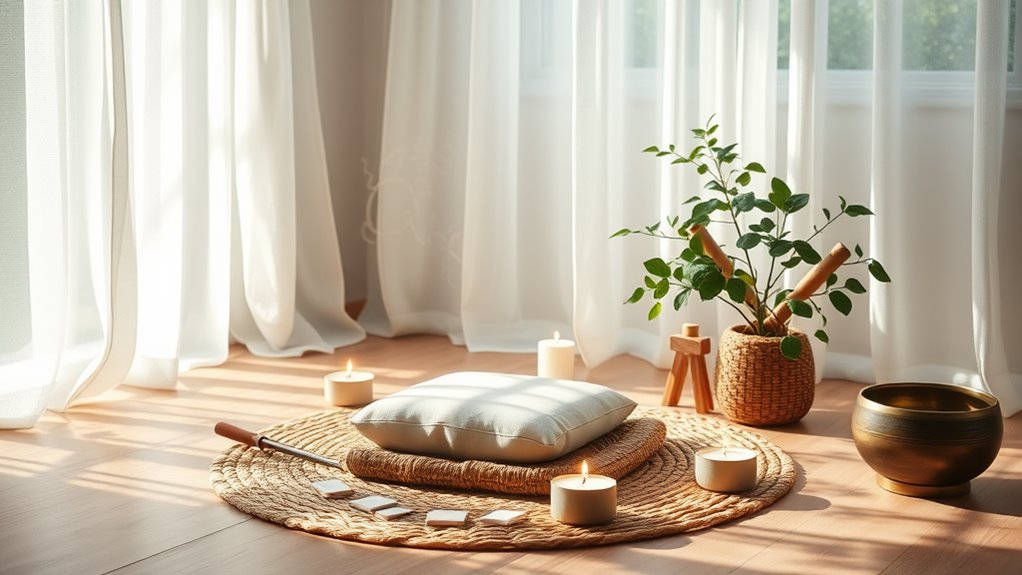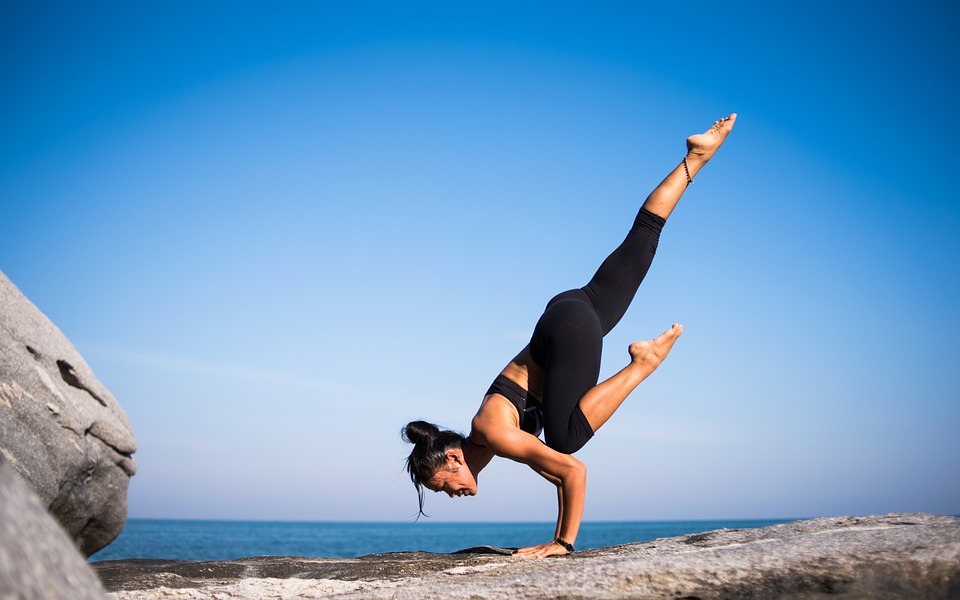
To effectively reduce anxiety, embrace meditation practices like mindfulness and body scanning. Focus on your breath to ground yourself in the present, using short sessions at first and gently increasing duration over time. Explore loving-kindness meditations to cultivate compassion and lessen negative thoughts. Incorporate deep breathing and progressive muscle relaxation for immediate relief, activating your parasympathetic nervous system to ease tension. Scientific studies back these methods, showing how they can match the effects of some medications. Start with 10-15 minutes daily, using apps or resources for guidance. There’s more to discover as you integrate meditation into daily life.
Understanding Anxiety Reduction
When it comes to reducing anxiety, it’s vital to first understand what triggers this response in the body. The ‘fight-or-flight’ reaction, although essential for survival, often escalates without reason in those with anxiety disorders. This rush of adrenaline can make your heart race and your breath short, leaving you feeling out of control. By fostering anxiety awareness, you can begin to identify when this reaction starts and mindfully choose ways to manage it.
A powerful tool you have at your disposal is mindful breathing. It helps center your attention and shift focus away from anxiety’s clutches. As you become more aware of your breathing, you create space between the anxious thought and your response to it, breaking the cycle of stress. Regular practice of such relaxation techniques creates a reserve of calm to draw from in stressful times. Consistent routines can improve mood, energy, and sleep quality, enhancing your overall mental well-being.
Physical symptoms like shaking or a racing heart don’t have to dictate your actions; you’re in control. Recognizing and naming these symptoms empowers you to reclaim your life from anxiety’s grip. Don’t let it rob you of your moments. With the right knowledge and focused practice, you free yourself, releasing the freedom and peace your mind craves. Engage with your breath today, and edge closer to freedom.
Effective Meditation Techniques
In exploring effective meditation techniques for reducing anxiety, one powerful approach is mindfulness meditation. Immerse yourself in the present moment by focusing on your breath. Let go of judgments as you pay attention to thoughts, emotions, and physical sensations. Starting with short sessions, you’ll anchor your mind and gradually increase your practice as you find comfort. The beauty of mindfulness techniques lies in their ability to ground you, offering a serene escape from life’s chaos. Regular practice not only reduces anxiety symptoms but also leads to improved mental well-being, reinforcing emotional resilience over time.
As you cultivate mindfulness, consider pairing your routine with a relaxing herbal tea such as lavender, which is known for its calming properties. Complement your practice with loving kindness meditation. Here, you generate feelings of love and kindness first towards yourself, then expand that warmth to others, even those who challenge you. Using phrases like “May I be happy. May I be healthy” fosters compassion, essential for diminishing negative emotions. This powerful practice nurtures empathy, promoting liberation from anxiety’s grip.
Explore physical relaxation with body scan techniques; notice tension from head to toe, releasing tightness through deep breathing. Engage in guided meditation or visualization to transport your mind to a peaceful state.
These techniques are keys to revealing a peaceful, liberated mind, equipped to confront and diminish anxiety in your life.
Immediate Relief Methods

Although anxiety often feels overwhelming, immediate relief methods can provide quick pathways to calmness. One of the easiest approaches you can take is deep breathing. By inhaling slowly through your nose and exhaling through your mouth, you activate the parasympathetic nervous system, encouraging relaxation and clarity.
This method is versatile, whether you’re stuck in traffic or caught in tense meetings. Deep breathing tackles physical tension, guiding you toward a serene state.
Another powerful tool is guided imagery. By intentionally visualizing calming scenes—perhaps a sunlit beach or a lush forest—you create a tranquil mental escape. Through engaging the senses, these vivid images foster a peaceful internal environment, helping you to replace stress with serenity.
For maximum impact, find a quiet spot where you won’t be disturbed.
To harness the potential of these methods, consider their effective and practical application:
- Deep Breathing: Quickly enhances focus and reduces tension.
- Guided Imagery: Empowers you to mentally retreat to calming places.
- Mindfulness Meditation: Grounds you in the present, alleviating anxiety.
Additionally, incorporating progressive muscle relaxation can enhance stress relief by systematically tensing and relaxing muscles, further promoting relaxation and reducing tension.
Scientific Evidence and Benefits
Understanding how meditation practices work requires looking at the compelling scientific evidence behind them. Mindfulness-based stress reduction (MBSR) and mindfulness-based cognitive therapy (MBCT) are powerful tools for reducing anxiety. They’re not just alternatives; studies show MBSR matches the efficacy of escitalopram for anxiety disorders within an 8-week period.
Mindfulness meditation brings neurobiological changes by altering brain structures linked to attention and emotion regulation. Functional MRI scans reveal shifts in brain activity, influencing regions like the amygdala even outside meditation sessions. This highlights meditation’s profound impact on your mental freedom and emotional balance.
Mindfulness outcomes extend to physical health, offering broader liberation from anxiety’s chains. Chronic stress gets slashed, immune functions boost, and physiological stress markers like cortisol decrease. Such practices combat conditions like irritable bowel syndrome, fibromyalgia, and insomnia, ultimately paving the way for a healthier you.
Clinical trials support these benefits; mindfulness interventions greatly decrease anxiety, comparable to standard therapies, regardless of whether you’re healthy or have anxiety disorders. Meditation doesn’t just calm the mind—it fortifies the body against stress’s relentless grip, giving you the tools to break free and embrace holistic well-being. Regular exercise releases endorphins, which act as natural painkillers and mood boosters, complementing the benefits of meditation in stress reduction.
Integrating Meditation Into Life

When you start integrating meditation into your life, even small changes can lead to significant enhancements in your well-being. It begins with short 10-15 minute sessions, helping you ease into the practice without overwhelming your day.
Consistency is essential, and guided meditations available through free resources or meditation apps can be a great start. They offer structure and maintain your focus, allowing you to gradually embrace this path to freedom from anxiety.
Transform daily activities into mindful experiences. For example, mindful walking lets you immerse in the present moment, appreciating each step and breath.
Consider these strategies to seamlessly integrate meditation into your routine:
- Practice at convenient times: Meditate during lunch breaks or right before bed to fit meditation into your schedule.
- Start as a habit: Incorporate meditation right after waking up or pre-workout for consistency.
- Use meditation apps: They’re handy resources, perfect for providing guidance and keeping track of your progress.













